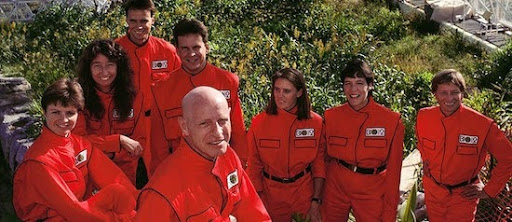REVIEW: “Spaceship Earth” is a timely documentary that trains the spotlight on the climate change crisis
2020 America is not the time or the place for the intellectual. We are living in a time that is aggressively pushing back against science and rational thinking. Extremely important environmental issues are being sidelined and/or dismissed by too many people in positions of power.
But there was a time, a time when idealists would come together to collectively find ways to improve life and to treat Mother Earth with more gentle hands so future generations could exist in a cleaner and healthier world.
The new documentary “Spaceship Earth” examines Biosphere 2, the self-contained replica of Earth’s ecosystem that was constructed in Arizona. It was a project that was wildly popular but, by the experiment’s end, fell prey to egos and accusations that would bring about its ugly downfall.
In 1991, with financial backing from billionaire philanthropist Edward Perry Bass, a group of eight scientists and artists entered the Arizona ecosystem that would be called Biosphere 2 (built in the late eighties) and would spend two years inside. No one could enter or leave and the inhabitants were instructed to grow their own food and plant life, maintaining their environment and controlling the oxygen.
One wouldn’t be out of line in thinking that NASA or some other government agency, foreign or domestic, was involved in this mammoth of a project but the crew was cast by John Allen, who headed a late sixties/early seventies commune, of sorts, called “The Theater of All Possibilities Touring Company.”
Allen was a Harvard graduate who was widely considered to be a genius and held the hope of sustaining the earth’s environment during the project so one day we could do the same in Outer Space. His thought process regarding this and his future Biosphere dome was born of the 1972 film “Silent Running,” where Bruce Dern played a scientist who keeps a greenhouse on a spaceship in the hope of repopulating Earth’s dying flora. Allen was a big fan of the film.
Through interviews and archival footage, we learn that not everyone supported Allen being the jefe of the project and its subjects. Some accused him of being a cult-like who used his important experimental ideas to entrap people.
The film never lets us get to know Allen beyond the surface, but I believe that that is just who the man was. After hearing him speak so eloquently about environmental issues and how what we do as a people effects the future of the planet, Allen was also accused of having a capitalist slant to his reasons for the success of the experiment.
Can financial interest be aligned with a desire to make the Earth a better place? This is a question the film raises but it does not give us any easy answers. This is something humanity must work out on its own.
Director Matt Wolf shows us how the shadowy light surrounding John Allen’s motives and methods ran parallel with the difficult living situation inside the biosphere.
In a case of be careful what you desire or you just might get it coming to fruition, the peaceful communal living preached by Allen and the sphere’s inhabitants would eventually give way to inner conflicts, isolation issues, injuries, and the life-threatening danger of excessive carbon monoxide levels. When the media coverage and sheen of the entire project began to recede, the ambitions of the project became eclipsed by the controversies surrounding its founder.
Cue Allen being removed from his own project and replaced by a young Steve Bannon. Jaw. Dropped.
Director Wolf uses the archival footage with aplomb. Like many filmmakers (especially those who film documentaries) he does have his slant and most definitely sides with the Biosphere’s inhabitants.
The personalities of the eight members are revealed through recent interviews and said archival footage. These are people who desired to make the world a better place and were proud to come together in their unified pursuit of this. They were all forward thinkers in a time when idealism shone bright.
It is here where Matt Wolf’s film also shines the brightest. We see these eight participants as they were, bright-eyed and with minds full of wonder and desire for change. Most of them were hippies who loved the arts and sciences and willfully blended the two. Hearing their tale of how it all came to be, taking note of their ambition and willingness to give all for a greater good is intoxicating.
One theme that runs throughout the film is how the ever-changing media can make or break any aspirations towards positive change in the country. Where the media outlets of their day painted Allen and his crew as heroic in their hope of saving the planet, today most create an atmosphere of division and bombard us with information so grandly varied that it likely causes many to tune out and disassociate from real issues. The current climate crisis being the latest and most serious casualty, as the reports are so divisive and unsettling that there are now too many who refuse to take it seriously.
Matt Wolf doesn’t use his film to become voyeuristic nor does he reach for the titillating. There is no discussion of sexual situation or needs of eight people living together for almost three years and he does not dwell on the controversies and the bickering. We are treated to a few recordings where we hear members profess anger towards Allen before his removal and snippets of the aftermath, but Wolf never dwells on the negative or sensationalistic aspects of the story.
What the film gets right is bringing to light an important moment in history that has been all but forgotten. John Allen and his participants had big ideas and wanted to help the planet endure which, in turn, would allow humanity to exist.
Lofty aspirations? Perhaps, but it is beyond time to listen to our beloved Mother Earth and stand on the shoulders of the great minds who came before in the hope of saving our world.
Matt Wolf’s “Spaceship Earth” is a well-directed, timely, and inspiring documentary that brings to the surface not only the importance of the Biosphere 2 experiment but also its relevance to the climate change issues facing our world today.
news via inbox
Nulla turp dis cursus. Integer liberos euismod pretium faucibua




